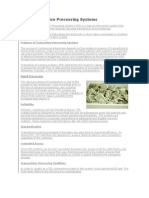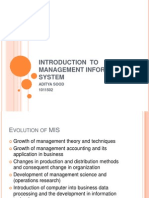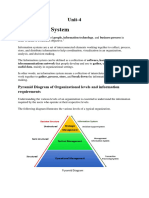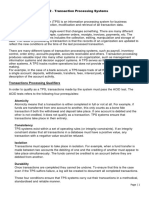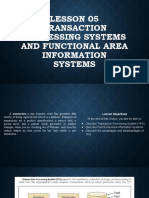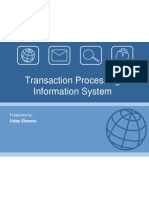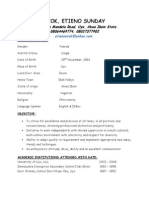0% found this document useful (0 votes)
913 views8 pagesTPS & MIS Essentials for Businesses
Transaction processing systems (TPS) rapidly process transactions to ensure smooth data flow throughout an enterprise. They exhibit characteristics like rapid processing, reliability, standardization, and controlled access. Transactions must pass the ACID test of atomicity, consistency, isolation, and durability. There are two types of transactions - batch processing and real-time processing.
Management information systems (MIS) integrate computer systems with organizational goals and objectives. They assist executives through processing information, producing reports, and providing decision support. MIS provides benefits like supporting strategy, data processing, management by objectives, enhancing supply chain management, and allowing for quick reflexes.
Decision support systems (DSS) are computer applications that enhance decision making. They help
Uploaded by
getalok4uCopyright
© Attribution Non-Commercial (BY-NC)
We take content rights seriously. If you suspect this is your content, claim it here.
Available Formats
Download as PDF, TXT or read online on Scribd
0% found this document useful (0 votes)
913 views8 pagesTPS & MIS Essentials for Businesses
Transaction processing systems (TPS) rapidly process transactions to ensure smooth data flow throughout an enterprise. They exhibit characteristics like rapid processing, reliability, standardization, and controlled access. Transactions must pass the ACID test of atomicity, consistency, isolation, and durability. There are two types of transactions - batch processing and real-time processing.
Management information systems (MIS) integrate computer systems with organizational goals and objectives. They assist executives through processing information, producing reports, and providing decision support. MIS provides benefits like supporting strategy, data processing, management by objectives, enhancing supply chain management, and allowing for quick reflexes.
Decision support systems (DSS) are computer applications that enhance decision making. They help
Uploaded by
getalok4uCopyright
© Attribution Non-Commercial (BY-NC)
We take content rights seriously. If you suspect this is your content, claim it here.
Available Formats
Download as PDF, TXT or read online on Scribd
/ 8
